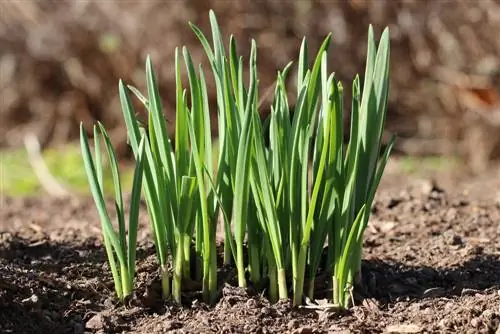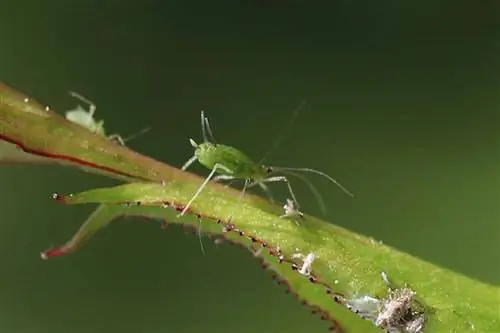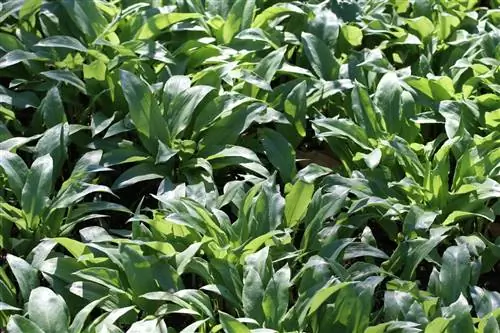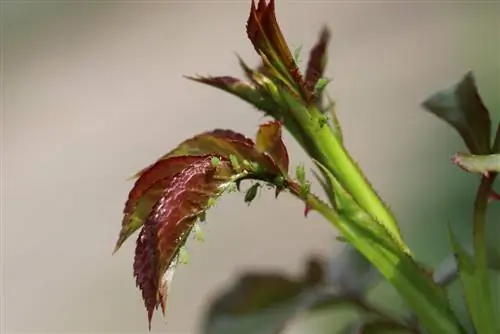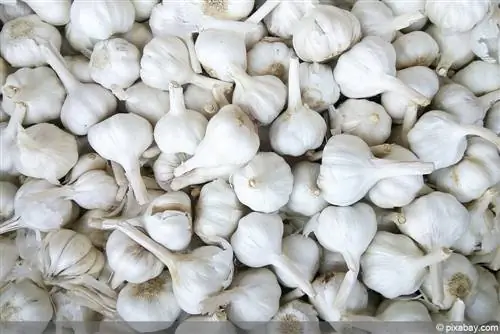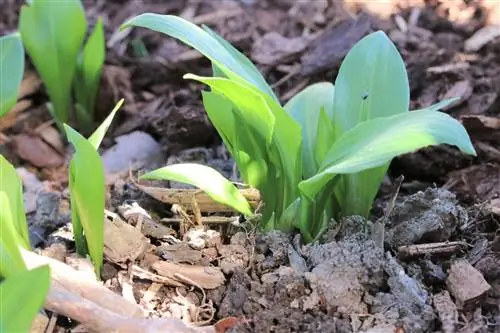- Author admin [email protected].
- Public 2023-12-17 03:39.
- Last modified 2025-01-24 12:45.
Garlic is delicious and he althy, green garlic is also delicious, but not in the clove in the fridge, that only makes it bitter. But you can plant garlic, first harvest the greens and then the cloves - it's super easy, and the garlic doesn't need much care.
Garlic and garlic clove
Garlic belongs to the order Asparagus, the Amaryllis family, the Allium subfamily and the Allium genus. Even if it's not an amaryllis, the Allium sativum certainly has flowers as beautiful as some ornamental onions. Knob leeks (knob goes back to an Old High German word for “split”, because of the “split” cloves) are better known as a spice than for their beautiful flowers; more and more people are cooking a lot with the delicious and he althy garlic cloves. These toes are the survival organs of the perennial leek plant; in addition to the main clove, five to twenty secondary cloves are formed, and sometimes also breeding bulbs.
Best time to plant garlic
The clove that we press into tzatziki, aioli or spaghetti sauce is also what the next garlic grows from. For perennial and winter-hardy garlic, these garlic cloves can be put into the ground in spring or autumn. If you put a garlic in the garden just for ornamental purposes, even at some point in between, it won't necessarily produce beautiful big cloves if it's "confused." If you want to harvest, you should stick to the rhythm, garlic first lets the so-called round bulb (the main clove) grow and only after a certain time does the daughter bulbs (cloes) begin to form. In the spring, garlic would have to be planted very early (at the end of February) so that the harvest in the fall would be reasonably plentiful, otherwise there would only be an enlarged round or thin, isolated cloves. That's why September to the beginning of November are the best times for planting, then the round will grow enough into the winter to produce many daughter bulbs (a proper garlic bulb) in the next growing season. The winter cold stimulus is said to have a positive effect on the growth of the onion, it will turn into a beautiful, large bulb next summer (July to August).
Floor
Garlic grows best in loose and nutrient-rich soil, a garden soil mixed with sand that is well mixed with humus, e.g. B. You are welcome to enrich the soil with ripe compost the previous autumn; garlic does not like freshly dug or freshly fertilized soil. For pots/flower boxes you can use garden soil mixed with sand as a substrate, or alternatively potting soil with sand. Protection against waterlogging is particularly important here, so there should be drainage (a layer of gravel or stones) at the bottom of the pot in addition to the permeable substrate.
Best location for garlic
Depending on where you got your garlic (see below for garlic varieties), it needs a lot of sun or a lot of sun, especially in the early stages of cultivation. Garlic likes to grow next to, between and under strawberries, cucumbers, raspberries, lilies, carrots, fruit trees, roses, beets, tomatoes and tulips. He also keeps a number of pests away from them (which hardly threaten him). Bad neighbors include beans, peas, cabbage and other nitrogen-producing legumes.
Planting garlic
is simple:
- Put the toe into the soil about 4 centimeters deep with the tip pointing upwards
- This is quick if you pre-drill holes with the planting wood
- At a distance of around (at least) 10 cm
- Garlic thrives in the bed and in the pot on the windowsill
- You can also put germinating garlic cloves of Mediterranean varieties in pots
- If your garlic variety forms bulbs (see below for garlic varieties), they are planted similarly (not quite as deep)
- It should take them a season longer until they develop beautiful tubers
Garlic Care
Garlic should be kept evenly and regularly moist until it grows, after which you don't have much to do with the garlic. He always needs a little moisture in the ground, but doesn't want to stand soaking wet, everything is completely normal. Garlic is hardy, but a cover of straw/brushwood/mulch is still good for it. This also protects it a little from rain; too much rain is usually more damaging to garlic than frost. On a balcony that is exposed to rain, it is even better to grow garlic on the rain-protected wall of the house in winter.
Fertilizer
Garlic doesn't necessarily need fertilizer; in well-maintained, nutrient-rich soil, the medium feeder can survive the winter without it. You can pamper him next spring: researchers from the Zhang Yin Xiong Li Lu Guo Xisheng Fertilizer Institute and the Anhui Academy of Agricultural Sciences (sorry, but in China they grow “a little more” garlic than we do and therefore did more research). studied the effect of fertilizers on the garlic crop and found that garlic developed the highest levels of vitamin C and soluble sugars when fertilized with nitrogen and potassium 1:1 + 1/2 phosphorus. For example, stable manure contains almost 2 g of nitrogen, potassium and 0.8 g of phosphorus per kg (general average, depends on what the animals have eaten), around 2.5 kg per square meter per season. It's better to avoid synthetic fertilizer, even in this composition, if you want the guests at the barbecue party to be as enthusiastic about your tzatziki as ever.
Harvesting and storage
If you planted in the fall, you can harvest from early next summer. First of all, the garlic green, which tastes a bit like garlic with a hint of chives and the olfactory aftereffects are much less noticeable than the garlic clove itself. If your garlic variety produces flower stalks, you can cut them away before bulbs form, then the bulbs will be larger. You can also leave a few stems and replant the bulbs directly towards the end of the year. The cloves are harvested when a third of the garlic leaves are wilted. If you use the tubers fresh, the release will be gentler, and you can braid the rest of the harvest and hang it up to dry. You can use the harvest to plant a few cloves again for the next season, which will then produce further harvests.
Garlic varieties
Allium sativum is only available as a cultivated plant, it came to us in the cultivated form from Central and South Asia, the wild type is considered extinct. This cultivated garlic is available in two varieties and many cultivars:
1. Allium sativum var. sativum, the actualcultivated garlic that you usually buy in stores. Its characteristics:
- It grows with low, fairly straight shafts with a rough edge
- The bulb has smaller toes on the inside than on the outside, the numerous side bulbs grow elongated
- It does not produce flower stalks and therefore no bulbs
- In international trade, this breeding selection is called “Softneck”
- China is the world's main export country, hence the research cited above
2. Allium sativum var. ophioscorodon is amore original form of cultivated garlic:
- It forms funny, serpentine curved foliage, bulbs with a few large, rounded secondary bulbs and flower stalks with breeding bulbs that ensure next year's harvest
- This variant is known in international trade as “Hardneck” (Stiffneck), in Germany as tiered garlic or snake garlic or (in gourmet restaurants) as Rocambole
- It grows well in northern areas, a great garlic for gardens and windowsills
- In rarity nurseries you can find it in a pot or as a breeding tuber depending on the season
The cultivars
There are subtypes and cultivars of softnecks and hardnecks. An introduction to the several hundred cultivars would go beyond the scope of the article, and is (unfortunately) not necessary at the moment, as the only planting material sold is nameless universal garlic or Rocambole. If you are interested in the varieties, which vary greatly in terms of ripening time, size and storage capacity, you could find them in English rarity nurseries, and occasionally at German weekly markets or specialist nurseries. Even in stores there are rarely variety names, only white and perhaps pink tubers from China, Argentina and Spain. You can certainly put them in a pot when they germinate; these “warmth children” usually do not survive German winters. Of course it can't hurt to try, but a rich harvest in the garden requires planting material from garden shops that is adapted to our climatic conditions.
Use garlic
So that garlic enjoyment is truly a pleasure, here are some important tips on processing:
- The unpleasant after-effects come from sulphur-containing compounds
- Garlic initially only contains precursors; after the cells are injured (pressed through or crushed into a pulp with the back of a knife), the actual active ingredient, allicin, is formed
- When garlic is heated, several other sulfur-containing compounds are formed
They later emit “small smells” through your breath and skin, but they also do a lot of good:
- They have an antithrombotic effect, prevent arteriosclerosis and colon cancer and have a general antibacterial effect
- Garlic also contains selenium, which most modern people are said to be deficient in
- Selenium has an antioxidant effect and binds heavy metals in the body
- In times when traces of metal in the human body are suspected of promoting/causing all sorts of diseases, reason for daily garlic consumption
This once again shows how much sense of effectiveness traditional kitchen tools (such as garlic presses) work with:
- You benefit most from the active ingredients when crushed garlic is used
- It should only be cooked briefly in hot dishes
- Sensitive people tolerate garlic better if the germ in the center of the bulb is removed (even if it is still white)
- Green germs make garlic bitter, they should be planted better
- According to a study by Ohio State University, milk neutralizes 50% of sulfur compounds in breath
- Other good anti-smell agents: chlorophyll (e.g. in parsley) and ginger
Conclusion
Garlic is a type of general medicine that you certainly shouldn't withhold from your body. Growing it is terribly simple, the garlic green hardly has any smell effects - nothing stands in the way of a he althier life with garlic.

